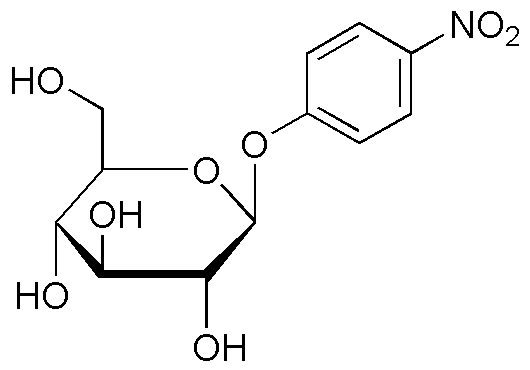4-Nitrophenyl-b-D-glucopyranoside is widely utilized in research focused on:
- Enzyme Activity Assays: This compound serves as a substrate for various glycosidases, allowing researchers to measure enzyme activity and kinetics in biochemical studies.
- Carbohydrate Research: It is used in the study of carbohydrate metabolism and the role of glycosidases in biological systems, providing insights into metabolic pathways.
- Drug Development: The compound aids in the design and testing of new drugs targeting glycosidase enzymes, which are important in treating diseases like cancer and diabetes.
- Biotechnology Applications: It is employed in the production of biofuels and biochemicals, where glycosidases play a crucial role in breaking down complex carbohydrates.
- Diagnostic Tools: This chemical is used in developing diagnostic assays for detecting glycosidase-related disorders, enhancing the accuracy of medical testing.
General Information
Properties
Safety and Regulations
Applications
4-Nitrophenyl-b-D-glucopyranoside is widely utilized in research focused on:
- Enzyme Activity Assays: This compound serves as a substrate for various glycosidases, allowing researchers to measure enzyme activity and kinetics in biochemical studies.
- Carbohydrate Research: It is used in the study of carbohydrate metabolism and the role of glycosidases in biological systems, providing insights into metabolic pathways.
- Drug Development: The compound aids in the design and testing of new drugs targeting glycosidase enzymes, which are important in treating diseases like cancer and diabetes.
- Biotechnology Applications: It is employed in the production of biofuels and biochemicals, where glycosidases play a crucial role in breaking down complex carbohydrates.
- Diagnostic Tools: This chemical is used in developing diagnostic assays for detecting glycosidase-related disorders, enhancing the accuracy of medical testing.
Documents
Safety Data Sheets (SDS)
The SDS provides comprehensive safety information on handling, storage, and disposal of the product.
Product Specification (PS)
The PS provides a comprehensive breakdown of the product’s properties, including chemical composition, physical state, purity, and storage requirements. It also details acceptable quality ranges and the product's intended applications.
Certificates of Analysis (COA)
Search for Certificates of Analysis (COA) by entering the products Lot Number. Lot and Batch Numbers can be found on a product’s label following the words ‘Lot’ or ‘Batch’.
*Catalog Number
*Lot Number
Certificates Of Origin (COO)
This COO confirms the country where the product was manufactured, and also details the materials and components used in it and whether it is derived from natural, synthetic, or other specific sources. This certificate may be required for customs, trade, and regulatory compliance.
*Catalog Number
*Lot Number
Safety Data Sheets (SDS)
The SDS provides comprehensive safety information on handling, storage, and disposal of the product.
DownloadProduct Specification (PS)
The PS provides a comprehensive breakdown of the product’s properties, including chemical composition, physical state, purity, and storage requirements. It also details acceptable quality ranges and the product's intended applications.
DownloadCertificates of Analysis (COA)
Search for Certificates of Analysis (COA) by entering the products Lot Number. Lot and Batch Numbers can be found on a product’s label following the words ‘Lot’ or ‘Batch’.
*Catalog Number
*Lot Number
Certificates Of Origin (COO)
This COO confirms the country where the product was manufactured, and also details the materials and components used in it and whether it is derived from natural, synthetic, or other specific sources. This certificate may be required for customs, trade, and regulatory compliance.


